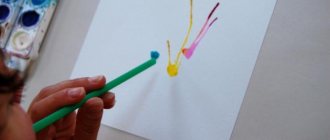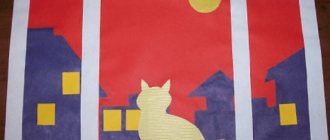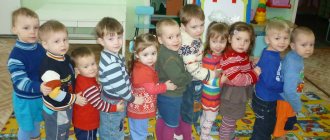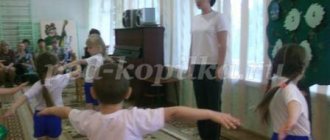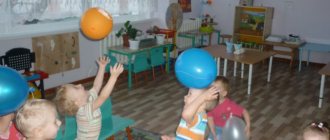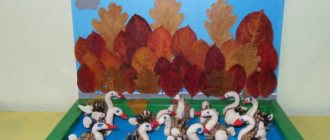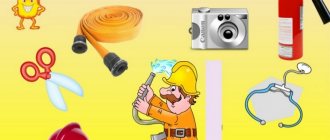We determine the goals and content of the open lesson
Inviting guests to a kindergarten group is considered one of the effective forms of organizing the methodological process in a preschool institution. This event includes a range of different knowledge and skills that are demonstrated by the teacher and children. Pupils of the preparatory department, as a rule, already cope with the proposed tasks quite independently and consciously.
Objectives of an open mathematical lesson
Like any practical educational activity, an event of this type solves three groups of problems:
- Educational tasks are aimed at developing certain mathematical concepts in children or at consolidating them (in the preparatory group this can be quantity and counting within 20, geometric figures and quantities, time or spatial concepts).
- Developmental tasks involve improving thought processes, attention, perseverance, speech, the ability to defend one’s point of view, and analyze mistakes. All techniques are aimed at developing the student’s active position (curiosity, keen interest in knowledge) and contribute to his socialization.
- Educational tasks are closely related to content. If it is based on a fairy tale (for example, “Geese and Swans” or “Pinocchio”), it instills in children an interest in folklore and literary works. The inclusion of patriotic elements fosters love for the native land, animalistic motifs foster a desire to take care of animals, etc.
Innovative content
Modern work on the study of mathematics should have an element of novelty and reflect the creative experience of the teacher. This can be non-standard didactic material or innovative techniques for mastering a topic (for example, the lesson can be integrated - built in the form of a sports competition, where all competitions are simultaneously related to mathematics).
Despite the use of an innovative approach, each child should receive the same amount of knowledge as if the topic had been studied under normal conditions. It is also unacceptable to explain to preschoolers only a separate part of the topic - one that can advantageously demonstrate an interesting methodological technique, ignoring other aspects (or transferring them to the next time).
Organizational aspects
The most important stage of work is preparation for viewing, for which sufficient time is always allocated. A passionate teacher who strives for self-education is interested in such events because they allow him to better assess his capabilities and take a fresh look at the children's team.
In order for 30 minutes of time to pass successfully, all planned goals to be realized and the topic to be fully covered, the teacher needs a detailed outline. All stages of activity, all actions and words of the teacher are written down there. In addition, theoretical and visual material is being prepared, which must be agreed upon with the preschool educational institution methodologist.
The author must also take care in advance of the space for the upcoming work (after all, mathematical classes are not always held in a group room), and check the multimedia equipment.
The duration of the reporting lesson is the usual 30 minutes. The teacher should not conduct “rehearsals” with the children in advance - from the outside it is always very clear: the children will not behave naturally, but will try to correctly fulfill their “role”.
On one day, several important events (two or three) can be carried out sequentially in a preschool institution, which are then discussed at the general council. However, as pedagogical practice shows, it is unacceptable to conduct two non-standard classes in different subjects one after another with children of the same group: this is a large psychological burden for adults and children.
Immediately before the educational event, the teacher presents to his colleagues its characteristics, which are drawn up according to a specific plan.
Open lesson characteristics plan - table
| Characteristics of the group | Age characteristics of children. The degree to which children have assimilated the program. Real learning opportunities for children. |
| Description of the project for the upcoming lesson | Determining the place of the lesson in the topic, section, etc. Listing the goals and objectives of the lesson. Familiarization with the content of educational material. Sounding out the structure of the lesson. |
| Justification of the project for the upcoming lesson | Justification of the relevance of the chosen lesson topic. Identifying the connection between the topic of the lesson and the methodological problem, the topic of self-education, on which the teacher is working. |
| Open class prospectus | Voice the topic and title of the lesson. Formulation of methodological innovations proposed in the upcoming lesson. A brief structural summary of the most interesting element of the lesson: • voicing the supporting notes; • presentation of samples of didactic materials (didactic games, handouts, sample, etc.); • distribution of leaflets, booklets; • reading out the list of used literature. |
Also, during preparation, the teacher makes a forecast of expected results and possible risks. For example, children can be active in the game or indifferent to what is happening, enter into dialogue with the leader and even argue or give a long monologue.
As for the presence of a certain number of adults in the room, it is necessary to inform children about this in advance so that they can prepare psychologically. Guests should not distract preschoolers with their appearance: for this purpose, their workplaces are usually located behind the children’s backs.
Guests should not attract attention to themselves
The number of invitees should not be too large, otherwise it creates discomfort for the participants: this is why video recording is now widely practiced.
In rare cases, parents of preschoolers are invited: for them this is a wonderful way to see their child’s talents and skills in mastering mathematics, and to understand that they have a reason to be proud of their son or daughter. It is necessary to discuss in advance with adults the inadmissibility of interference in the process, in particular, not to try to suggest anything to your child. Parents can film what is happening with a camera or video camera.
Current methodological techniques for mastering mathematics
To be successful, the teacher must use unconventional ideas that will captivate children and interest colleagues.
- First of all, this is an intriguing start. Of course, you can’t do without a game component: the appearance of a famous fairy-tale hero or a message from him, an unexpected offer to go on a journey, fly into space, turn into wizards, etc. Moreover, the role of the game character can well be played by a child dressed in an appropriate costume.
- A gaming form that uses maximum visibility and paraphernalia (balloons, chests with secrets, toys, costumes, non-traditional materials).
- The integration of various subjects is always a win-win option: mathematical concepts easily fit into visual and speech activities, knowledge of the surrounding world, and physical education. A change of activity helps to relieve children psychologically and develops cognitive interest.
- Mandatory individual approach. The teacher always knows well the psychological characteristics of each of his students, so someone should repeat the question twice or ask it in a slow tone, someone has a faster reaction, and such a child should be involved in outdoor play.
Analysis of an open lesson
At the end, the teacher, together with his guest colleagues, reflects on his activities, noting the most successful aspects and highlighting those points that should be corrected in the future. First, the author is given the floor: he recalls the main tasks and assesses the degree of their implementation.
A friendly atmosphere during the discussion will support the author
During the discussion, there is consultation of guests, self-reflection (the teacher notes what he coped with easily and what caused difficulties), exchange of opinions and even discussions.
Summaries of all reporting activities with comments to them are stored in the methodological office of the preschool educational institution.
Methodology for conducting an open lesson in mathematics (structure, forms of work)
Each math lesson has a specific structure. It begins with an introductory motivational moment. Most of the time is occupied by the main part, which reveals the topic (mastering or consolidating mathematical concepts that are relevant for the preparatory group). At the final stage, the teacher sums up the results of the activity, and the preparatory group students themselves draw conclusions: what they liked seemed difficult.
As for the forms of work of pupils, individual tasks are offered (at the workplace, children make pictures from geometric shapes, counting sticks, compare quantities, etc.), work in pairs (for example, speed testing or with mutual testing) and collective activities (moving or musical game with mathematical content).
Individual assignments are one of the forms of work in an open lesson on FEMP in the preparatory group
You can choose any topic for an open mathematical lesson, not too broad, but not too narrow. You can summarize the results of a certain time period. An interesting idea is to time the action to coincide with a holiday. For example, on the eve of the New Year, you can play out a fairy tale, where forest animals-children, who can be dressed up in costumes, will perform exciting mathematical tasks. An open lesson on FEMP before Defender of the Fatherland Day will be associated with patriotic and military motives (they are included in problems and game situations). And those held on the eve of March 8 or Mother’s Day should contain a feminine gift theme, for example, one of the tasks is to make a beautiful dress for mom or a bouquet of flowers from geometric shapes (the theme is a repetition of the composition of the number). Traveling to the land of Mathematics, Africa, space, the Island of Knowledge, the North Pole is always fascinating.
Children must prepare a spaceship for launch
The theme could also be an immersion in a famous fairy tale (“Geese and Swans”, “The Twelve Months”, “Cinderella”, “Sleeping Beauty”, “The Snow Queen”). Any fairy-tale plot, if desired, can be associated with mathematical content and come up with appropriate moves that will interest children and surprise guests of the event. For example, in the fairy tale “Geese and Swans”, the main character is given tests by a stove, an apple tree, a river (compare the length of bridges and choose the most suitable one, bake a “delicious” cake from geometric shapes, etc.).
Motivation of children
An intriguing start to the lesson is the key to its success. The preparatory group is very fond of surprises, usually associated with the appearance of favorite fairy-tale characters.
A win-win option for motivation is the character asking for help. Children, especially at 5–6 years old, consider themselves independent and adults, they like to feel important, and they happily agree to correct some situation.
- For example, the guys receive a letter from Buratino. He was locked in a room by the evil cat Basilio and the fox Alice and will be released only if he completes their tasks (they are in pre-prepared envelopes).
- Another example is when a crying girl (a student from a parallel group) runs into the room. She reports that the father and mother went to the city to get gifts, and she was asked to keep an eye on her brother. But little Vanya was carried away by the evil geese and swans. Preschoolers guess that the heroine came to them from the Russian folk tale “Geese and Swans”. The teacher invites everyone to go on a journey together, where interesting tasks will await the children.
Another motivation option is to offer children reincarnation (to temporarily become wizards, astronauts, sailors) . The teacher can invite preschoolers to visit amazing geometric islands where there is a lot of interesting things. To do this, they will have to become brave sailors: the guys are given the appropriate attributes - vests, caps, you can even build an improvised ship in advance. Another option is to go to distant Africa with Dr. Aibolit to help sick animals.
The guys will happily agree to become sailors for a while
Future students really like the situation of success, so the teacher can play on this desire. For example, he announces to the children that the fairy Mathematics has come to visit them today (a picture is shown or a disguised adult enters the group). The fairy has prepared a number of tasks and competitions to test the knowledge of preschoolers. And then she will choose the most attentive and active ones and reward them (of course, at the end of the lesson, all the children will receive gifts).
Fairy Mathematics wants to evaluate the knowledge of preparatory group students
Final lesson in mathematics “Journey to the country of Mathematics” as part of pre-school preparation
Final lesson in mathematics “Journey to the country of Mathematics” as part of pre-school preparation
Shchadnykh Tatyana Anatolyevna
primary school teacher
highest qualification category
MBOU "Secondary School No. 22" Kursk
Progress of the lesson:
“The bell rings - class begins!” (in unison)
— Guys, guests have come to our lesson, let’s try to be attentive and answer questions well. - What do you think is the subject of Mathematics - interesting or not? - Why do you think it’s interesting?
I received an unusual letter today: (I show who can read the address to whom)
(reading a letter to the children) “- Hello guys. I, the Queen of Mathematics, heard that you know numbers, figures, can count, compare objects and much more. That's why I have prepared a surprise gift for you. But to get it, you need to travel and complete my tasks. If you are brave, determined, confident in your abilities, then hit the road. Bon Voyage".
— Guys, do you like to travel?
Are you confident in your abilities and knowledge? Then let's go to math land!
Guess what we're going on a trip with today. There is a ladder in the field, The house is running up the stairs. (Train) (hang on board)
Go! (I give the whistle, the children imitate the sound and movement of the train.)
We didn’t even notice how we arrived at the “Mathematical Warm-up” stop (attached to the picture)
— Funny animals are going on a journey with us.
-Who rides between the cat and the fox? Who goes after the parrot? Who is in the trailer in front of the dog? Let's count the number of trailers. Who is traveling in the 4th carriage?
Turned our heads to the left. They raised their right hand. What number comes after 5, name the neighbors of the number 7.
Well done! (
They get the letter
M
). At the end of the lesson you will try to read the word
I attach it to the station)
Let's move on!! (beep, movements)
We arrived at the Zadachkino station
Make up a problem based on the picture so that it can be solved by addition. What is the sign for addition?
Let's come up with a solution to this problem. (They show the solution one by one with cards)
Make up a problem based on the picture so that it can be solved by subtraction. What is the sign for the subtraction action?
Let's come up with a solution to this problem. (They show the solution one by one with cards)
-Well done! You completed the tasks well and for this you receive a letter (o)
Let's move on!!
Let's get up and go! (repeat movements to music)
Next stop “Flower Glade”
Let's remember the counting from 1 to 10. You need to go through the colors, observing the correct order and sit down at the tables (receive the letter L
)
—Let's do gymnastics for the fingers.
- do the task in a notebook: solve examples and color the flower. (remember how to hold a pencil correctly)
Fragments of notes from open classes on FEMP in the preparatory group - table
| Full name of the author and title of the lesson | Fragment of the summary |
| Lebedeva O.V. "Fun mathematics with Pinocchio" | The group receives a letter from Pinocchio, who was locked in a closet by the cat Basilio and the fox Alice and will not be released until he completes their tasks. But the hero cannot cope with this alone. To the sound of cheerful music, preschoolers go along the path and find envelopes with tasks.
|
| Guardian M.A. "Math in Motion" | The lesson is held in the gym. Preschoolers are offered a number of tasks that integrate physical education and mathematics.
|
| Medvedeva L. “Journey to the Islands of Mathematics” | The teacher invites preschoolers to go on an exciting journey to the geometric islands - there are a lot of interesting things there. First you need to build a ship - on a piece of paper, each child connects the numbers in the right order and receives a corresponding image. Children “sail” to the first “Warm-up” island in the shape of a yellow square. Here children will have tasks to do: count from 1 to 10 and back, count from 10 to 5, determine the number that is greater than 3 by 4, etc. 2nd island: “Ponder” - blue circle. The teacher invites the children to play “Milchanka”: in response to a question, you need to show a card with a number or a geometric figure, but you cannot speak. Questions:
3rd island: orange oval – “Fishermen’s Island”. You need to catch fish with questions related to time concepts written on them: “How many seasons are there?” and so on. 4th island: “Rest” - red rectangle. A physical education session is held:
5th island: “Island of Wonders” - brown trapezoid. To attend it, you need to complete a task - under the dictation of the teacher, draw a picture according to the cells. The result is an image of a dog guarding the island. The dog asks you to answer the following questions:
6th island: “Task Island” - green triangle. A turtle made up of geometric shapes lives here. She asks the children a problem about how many flowers grow in the meadow, gives the children prizes (coloring books), and the teacher offers to build a house for her out of counting sticks. |
To master mathematics in a modern kindergarten, any colorful materials, story-based and role-playing games, didactic materials are used (Dyenes blocks, Cuisenaire sticks, counting cards, counting sticks, a cash register of numbers, magnetic numbers, shapes and mathematical signs), and exciting tasks are given that combine mastering mathematical concepts with the development of speech and motor skills.
Open lesson on mathematics in preschool - preparatory class
Open lesson on mathematics in preschool - preparatory class
Lesson: Mathematics Topic: Repetition of the studied material “Composition of numbers” Objectives: 1. Strengthen the skills of ordinal and quantitative counting within 10; 2. Form an idea of the relationship between the whole and the parts. 3. Strengthen the ability to increase and decrease numbers within the first ten by several units. 4.Repeat geometric shapes. 5. To foster independence, activity, accuracy in students, to develop logical thinking and memory. Method: verbal - visual, practical. Type: repetition. Khoduroka: 1. Organizational moment. The bell has rung for us! Everyone entered the classroom quietly. Everyone stood up at their desks nicely and greeted the guests politely. We sat down quietly, with our backs straight. Let’s all take a slight breath, and the lesson will begin now. Today we have an unusual lesson - the heroes of fairy tales will come to visit us with their mathematical tasks. They want to test your knowledge: how you can count, write, solve problems, solve riddles. Therefore, I ask you to be attentive and actively help me. And your help is your participation in the lesson. Guess the riddle, and you will find out which of the heroes came to us first. The grandmother loved the girl very much. She gave her a red cap. The girl forgot her name. Well, tell me her name. (Little Red Riding Hood) Little Red Riding Hood wants to know if we can count in forward order from 0 to 10, and in reverse order from 10 to 0. A) Count in ascending order from 0 to 10. B) Count in descending order from 10 to 0. C) Name your neighbors. D) Fill in the “box”. Little Red Riding Hood was carrying us a basket of apples and accidentally scattered them along the way. Let's help Little Red Riding Hood collect apples. To collect them you need to solve fun puzzles. Seven geese set off on their journey, Two decided to rest. How many are there under the clouds? Count it yourself, children. (5) Marinka entered the class. And behind her came Arinka, And then Ignat came. How many of the guys were there? (3) To prevent the cat from getting its feet wet, how many boots would she buy? (4) Five guys are playing football, one was called home. He looks out the window, counts how many of them play football? (4) Little Red Riding Hood liked it, do you think she was satisfied. There is a knock. To find out who came to visit us, we need to work in pairs. And the task is this: we need to assemble the parts into a single whole. (This is a chicken) The chicken came with its house. Tell me, what geometric shapes does the house consist of? The chicken asks us to help him populate the house with tenants. There are 6 residents on each floor. Now let's see who lives next door to the chicken. (The numbers are turned upside down, there are pictures of animals on the back). The chicken is very happy that we helped him. The chicken was tired and decided to rest. Let's relax together with him. Let's make as much clap over our heads as there are hedgehogs (2) So much clap in front of us How many squirrels? (4) Let's hide two hands behind our backs, and jump on two legs How many cubs? (3) A buzzing sound is heard. Someone else came to us. Let's guess who it is? The fat man lives on the roof, he flies higher than everyone else. (Carlson) Carlson wants us to help him go fishing. And fish are not easy with expressions. To catch the fish you need to solve examples. Come on guys, help Carlson catch the fish. Well done! We helped Carlson catch the fish. He is very pleased. Our fairy-tale heroes really enjoyed it here, because thanks to your knowledge and skills, you were able to cope with all the tasks and completed them together in harmony. “Being together is not burdensome, but at least throw it together” means always and everywhere to be one for all and all for one. What tasks did you perform? Which of the tasks did you like best? And to summarize the lesson, let's sing the song “True Friend.”
Related videos
It’s always interesting to watch the kids’ activities, even if you’re watching a video. From such videos you can glean new ideas and methodological techniques.
Attracting fairy-tale characters - video
In this process, the teacher plays the role of a hero from a well-known and beloved fairy tale.
“Journey to the Land of Mathematics” – video
The recording demonstrates interesting game techniques and tasks for preschoolers.
Math lesson in the music room - video
The activity space is the music room.
